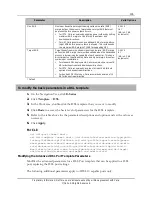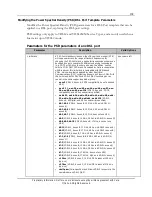
149
Proprietary Information: Not for use or disclosure except by written agreement with Calix.
© Calix. All Rights Reserved.
Ethernet and xDSL ports:
Circuit ID options:
Calix-format: <system-ID> eth <shelf>/<slot>/<port>:<Vlan-Id>[-<Vlan-
Id>]
TR-101-format: <system-ID> <iftype><shelf>/<slot>/<tr101port>:<cetag>
♦
The TR-101
iftype
should be either “eth” or “atm” (must be all lower case).
♦
The TR-101
cetag
should be one of 3 formats:
:vpi.vci for DSL lines/groups that are trained in ATM mode (tagged or
untagged)
:ce-vlan-id for tagged subscribers that are either PTM DSL lines/groups or
ONT
Null for untagged subscribers that are either PTM DSL lines/groups or ONT
Note:
If the xDSL port is a member of a bonded link group, the port within the xDSL
bonded link group with the lowest port value will be selected to fill the <port> field in
the Circuit-ID string.
Remote-ID options:
Subscriber ID of the port on which the DHCP lease request is received. The first
63 characters of the Subscriber ID text field are inserted.
none (no content is inserted)
Note:
The default Calix format will have a defining letter for the port (x,g,v,etc) followed
by the port number. The TR101 format will have a defining letter for the port followed
by the port number, except for the VDSL ports which will be only the port number (no
leading letter 'v').
To configure the global access-identifier profile for xDSL ports
1.
On the Navigation Tree, select
E-Series
.
2.
In the work area, click
Profiles > Access Identifier
to view the table of default access-
identifier profiles.
3.
Double-click the name of the profile that you want to configure:
eth-system-default
is used for xDSL and GE ports.
4.
In the Access Identifier Profile form, select the parameter from the attribute list:
Circuit ID list parameters:
calix-format
tr101-format






























